
New Analytics, Antenna and Cable Technology at AIX 2019
Avionics manufacturers and aircraft connectivity service providers are responding to airlines’ demands for faster connection speeds, more flexible architectures and aircraft data analytics platforms at the 2019 Aircraft Interiors Expo (AIX) 2019 in Hamburg, Germany. Here are some of the newest connected aircraft technologies and components that made their public debut on the second day of AIX. Panasonic Unveils ‘Insights’ Data Analytics Panasonic unveiled the latest component of its NEXT platform: a cloud-based analytics solution that harvests data from onboard and third-party sources from a wide range of touchpoints, including entertainment, connectivity, social media, location and weather monitors. It analyzes this data to help airlines improve the onboard passenger experience, pre-emp maintenance needs and drive revenue. Airlines will also have access to seasonal and temporal trends data through Insights, with the ability to benchmark their performance against industry averages and KPIs. Insights will be accessible via a secure dashboard on mobile devices. It has two components: A Software-as-a-Service (SaaS) application and Consulting. The SaaS component offers the data and insights described above while the Consulting piece offers airlines tailored solutions for specifics challenges. Consulting will also release monthly trends reports based on Panasonic’s global data, available by monthly subscription. “Airlines today have access to more data points than ever before, and Panasonic’s Insights solution takes all the leg-work out of analyzing and leveraging that data,” said David Bartlett, chief technology officer of Panasonic Avionics Corporation. “By fully integrating Insights across every aspect of their passenger experience, airlines will be able to use the information it delivers to optimize their passenger experience and business performance,” he added. “It is solutions like this that will enable airlines to remain competitive in the saturated market place and continue to grow their market share.” Insights will be available in the second half of 2019, according to Panasonic. Viasat’s Second-Generation Hybrid Ku/Ka-band System Viasat has a new second-generation Ku-/Ka-band shipset, including a hybrid antenna and complimentary radome. The shipset will allow airlines to provide connectivity via today’s Ku- and Ka-band networks as well as prepare for the global ViaSat-3 constellation planned for launch in 2021 and 2022. “Hybrid antenna systems are not new to Viasat—we have nearly two decades of experience deploying and managing these systems,” said Don Buchman, vice president and general manager for commercial Aviation at Viasat. “Similar to the first generation, Viasat’s latest dual-band system promotes smooth transitions among multiple satellite beams across Ku- and Ka-band networks.” When flying on routes with the hybrid shipset installed, customers will have in-flight access to all Ka-band satellites currently participating in Viasat’s global network. When out of Ka-band coverage, service will switch to the Ku-band network. Once the Viasat-3 constellation is fully deployed — which the company estimates will happen in 2022 — global Ka-band coverage will be available. SmartSky Selects Gore’s Vapor-Sealed 7 Series Cable Assemblies SmartSky Networks selected Gore’s vapor-sealed 7-series for their new in-flight connectivity system that provides 4G LTE air-to-ground (ATG) connection in aircraft such as the Embraer ERJ-135 operated by JetSuiteX. The connectivity system has now received supplementary type certification for the ERJ-145. “Gore’s 7 Series is high performance and exceptionally reliable, enabling a real fit-and-forget installation to exceed our customers’ expectations now and for many years to come,” said Darren Emery, vice president for product support at SmartSky.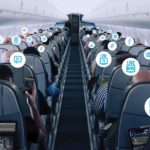
Viasat, China Satcom Bring IFC to Airlines Over China
Viasat and China Satellite Communications (China Satcom) entered into a strategic partnership to jointly provide In-Flight Connectivity (IFC) services within China for domestic and international airlines. Viasat and China Satcom will help enable Viasat’s global airline customers to have roaming connectivity when flying over China; provide IFC service to domestic flights within China; and enable Chinese airlines to roam onto Viasat’s global network. China Satcom is a licensed telecommunications service provider in China and also owns and operates a Ka-band spotbeam satellite system in China, which is the only Ka-band system currently available for IFC service in the country. Yet today, only about four percent of flights within China are connected. “Our agreement with China Satcom is a significant step towards realizing a seamless global community of high performance IFC. China Satcom is now the only satellite operator and licensed service provider in China with the bandwidth resources to deliver the in-flight experience our airline customers have come to expect and depend on,” said Don Buchman, vice president and general manager, Commercial Aviation, Viasat. “Our partnership is a natural way to extend state-of-the-art services specific to China Satcom’s fleet and the China domestic market, and create a global roaming alliance for our existing and new domestic and international customers and the rapidly growing Chinese global commercial airline fleet. We are honored to work with China Satcom in China to make IFC-at-scale a reality.”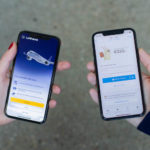
AIX 2019: Airlines Seek a Connected Aircraft Digital Sweet Spot

In January, the Lufthansa Group and the Lufthansa Innovation Hub established a new research alliance with Hopper focused on the subject of artificial intelligence. That was their third technology-related investment within a year, following investments in the startups Fleet Logistics and cargo.one. Photo: Lufthansa Group

EASA Proposes New Aircraft Cybersecurity Certification Amendments
 The European Aviation Safety Agency (EASA) is proposing new cybersecurity amendments to the way aircraft electronic networks and systems are certified.
Under the new amendments, manufacturers and operators seeking certification of new aircraft systems and networks or modifications to existing ones will be required to address threats that can lead to unauthorized access and disruption of electronic information or electronic aircraft system interfaces. EASA is proposing the new amendments to address the growing presence of connectivity within modern aircraft network designs.
“Since aircraft systems are increasingly connected, and thus potentially vulnerable to security threats, EASA needs to consider the state-of-the-art means of protection against these threats when certifying new products or parts,” the agency said in the NPA.
EASA identified seven different certification specifications areas, including technical regulatory requirements for business jets, commercial airliners and rotorcraft. Amendments were developed based on recommendations provided by an Aviation Rulemaking Advisory Committee (ARAC) that was tasked by the FAA with standardizing the way aircraft systems are protected from emerging cyber threats. The amendments will also introduce more harmonization between EASA and FAA regulations.
As more satellite and air to ground-based connectivity has been introduced onto aircraft over the last decade, the industry has relied upon the separation of aircraft networks into three different domains: aircraft control, airline information and passenger information domains.
EASA’s proposed amendments focus solely on protecting the aircraft control domain, which features safety-critical flight controls used by pilots. As aircraft system designs evolve from point-to-point data bus communications to standardized protocols connected by switched Ethernet, they are increasingly susceptible to new cyber threats.
“These interconnections are susceptible to new threats, which may potentially have catastrophic effects on the safety of air transport. Those threats are caused by unauthorized electronic interaction that can be triggered by human action either intentionally or unintentionally,” the agency said.
The proposed amendments come as cyber attacks on airline and aircraft networks are increasingly occurring. As an example, in October 2018, Cathay Pacific reported the largest data breach ever suffered by a commercial airline when a hacker accessed information about 9.4 million of its customers. Alaska Airlines was also at the center of a major attack in 2017 when it merged with Virgin America.
Researchers with cybersecurity firm IOACTIVE also demonstrated their ability in late 2017 to hack into a live commercial aircraft satellite communications modem. EASA made it clear within the proposed amendments though that it is only concerned with threats to the safe operation of aircraft or continued airworthiness of systems or parts. Those would not include the type of attack demonstrated by IOACTIVE, or the data breach suffered by Cathay.
EASA is seeking industry comments on the new amendments through May 22, 2019, and expects to make a decision on implementing the new rules by the third quarter.
The European Aviation Safety Agency (EASA) is proposing new cybersecurity amendments to the way aircraft electronic networks and systems are certified.
Under the new amendments, manufacturers and operators seeking certification of new aircraft systems and networks or modifications to existing ones will be required to address threats that can lead to unauthorized access and disruption of electronic information or electronic aircraft system interfaces. EASA is proposing the new amendments to address the growing presence of connectivity within modern aircraft network designs.
“Since aircraft systems are increasingly connected, and thus potentially vulnerable to security threats, EASA needs to consider the state-of-the-art means of protection against these threats when certifying new products or parts,” the agency said in the NPA.
EASA identified seven different certification specifications areas, including technical regulatory requirements for business jets, commercial airliners and rotorcraft. Amendments were developed based on recommendations provided by an Aviation Rulemaking Advisory Committee (ARAC) that was tasked by the FAA with standardizing the way aircraft systems are protected from emerging cyber threats. The amendments will also introduce more harmonization between EASA and FAA regulations.
As more satellite and air to ground-based connectivity has been introduced onto aircraft over the last decade, the industry has relied upon the separation of aircraft networks into three different domains: aircraft control, airline information and passenger information domains.
EASA’s proposed amendments focus solely on protecting the aircraft control domain, which features safety-critical flight controls used by pilots. As aircraft system designs evolve from point-to-point data bus communications to standardized protocols connected by switched Ethernet, they are increasingly susceptible to new cyber threats.
“These interconnections are susceptible to new threats, which may potentially have catastrophic effects on the safety of air transport. Those threats are caused by unauthorized electronic interaction that can be triggered by human action either intentionally or unintentionally,” the agency said.
The proposed amendments come as cyber attacks on airline and aircraft networks are increasingly occurring. As an example, in October 2018, Cathay Pacific reported the largest data breach ever suffered by a commercial airline when a hacker accessed information about 9.4 million of its customers. Alaska Airlines was also at the center of a major attack in 2017 when it merged with Virgin America.
Researchers with cybersecurity firm IOACTIVE also demonstrated their ability in late 2017 to hack into a live commercial aircraft satellite communications modem. EASA made it clear within the proposed amendments though that it is only concerned with threats to the safe operation of aircraft or continued airworthiness of systems or parts. Those would not include the type of attack demonstrated by IOACTIVE, or the data breach suffered by Cathay.
EASA is seeking industry comments on the new amendments through May 22, 2019, and expects to make a decision on implementing the new rules by the third quarter.
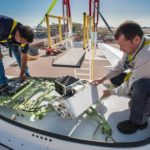
Air Esurfing Named Honeywell JetWave Sole Distributor in China
AirMedia Group revealed that one of its subsidiaries, Air Esurfing (ARE), has been selected as the sole distributor of Honeywell‘s next-generation JetWave satellite communications hardware in China. This gives Chinese airlines access to a solution that aims to provide high-speed, in-flight Wi-Fi service. According to the release, Honeywell’s JetWave satellite communications hardware aims to provide high-speed in-flight Wi-Fi service worldwide by establishing Ka-band communication links with the Global Xpress Network of the International Maritime Satellite Organization (Inmarsat Aviation) and satellite ChinaSat 16 and ChinaSat 18. “China plays a significant role in our global growth and we are committed to working with local partners to help advance the country’s aviation industry,” said Honeywell Aerospace President of Asia Pacific Steven Lien. “This exciting cooperation with ARE gives Chinese airlines a competitive edge in a globalized market – providing them with hardware and connectivity that delivers in-flight Wi-Fi with in-office speed.”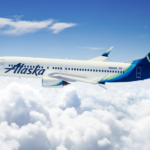
Alaska Airlines Adds Gogo 2Ku IFC
Gogo and long-time partner, Alaska Airlines, launched Gogo 2Ku high-speed connectivity and Gogo Vision wireless In Flight Entertainment (IFE) on an A321neo featuring the airline’s redesigned cabin interior. Alaska will have satellite Wi-Fi powered by 2Ku available to guests on most of its Boeing and Airbus mainline fleet by the end of 2020. Gogo 2Ku is an In Flight Connectivity (IFC) solution and delivers an internet experience comparable to what guests have on the ground, including the ability to stream video from popular streaming video services. 2Ku also has global coverage, which means guests onboard Alaska aircraft will have service nearly everywhere they fly — even over the ocean to Hawaii, where connectivity was not previously available. “Gogo 2Ku is a key feature of the seamless digital experience created by Alaska as part of its integration with Virgin America,” said Gogo Commercial Aviation President John Wade. “We are proud to be part of this transformation as two great airlines come together.”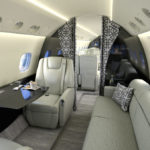
StandardAero Awarded SmartSky STC for Embraer Jets
StandardAero achieved the first supplemental type certificate (STC) for SmartSky’s in-flight connectivity system for an Embraer model aircraft type. Under the new STC, SmartSky’s system can be installed on the Embraer ERJ135/140/145 regional airliners and Legacy 600/650 business jets. The STC was awarded to StandardAero under its organization designation authorization from the FAA. The company is also working on additional SmartSky STCs for Embraer Legacy 450s and 500s, as well as Dassault Falcon 7X, 8X and 50EX models. “This allows a significant section of the aviation community to access SmartSky’s affordable and secure inflight connectivity solution,” says StandardAero Certification Services Director John Miedwig. SmartSky recently announced JetSuiteX as the official launch customer of its next-generation air to ground in-flight connectivity network. The company is anticipating full coverage across U.S. airspace by the end of 2019. Under the new STC, SmartSky’s system can be installed on the Embraer ERJ135/140/145 regional airliners and Legacy 600/650 business jets. The STC was awarded to StandardAero under its organization designation authorization from the FAA. The company is also working on additional SmartSky STCs for Embraer Legacy 450s and 500s, as well as Dassault Falcon 7X, 8X and 50EX models. “This allows a significant section of the aviation community to access SmartSky’s affordable and secure inflight connectivity solution,” says StandardAero Certification Services Director John Miedwig. SmartSky recently announced JetSuiteX as the official launch customer of its next-generation air to ground in-flight connectivity network. The company is anticipating full coverage across U.S. airspace by the end of 2019.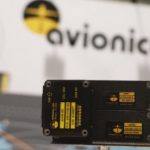
Addvalue, Avionica to Develop New SwiftBroadband Aircraft Terminals


Mobile World Congress: Telcos Look to AI and 5G
The rise and rise of Artificial Intelligence (AI) was at the heart of many keynote presentations on day one of Mobile World Congress (MWC) in Barcelona. José María Álvarez-Pallete López, chairman and Chief Executive Officer (CEO) of Telefonica — one of the world’s biggest telcos — spoke of how networks will get smarter as they become AI-driven. He gave the interesting statistic that mobile data traffic is growing at more than 50 percent every year, and said no other sector comes close to this level of growth. Interestingly, he was one of the speakers that urged governments not to look at 5G as a cash cow. “Why do we need to acquire the same spectrum over and over again? We need a refresh, and a bold regulatory approach,” he said. “The aim of regulators should be to reduce regulation. Governments are using spectrum as cash generators. Spectrum needs to be awarded for a longer period of time.” López spoke of the new global data sphere, and how we are flooded with data. However, he spoke of how this data revolution could help revolutionize sectors such as transportation and health, and how data now powers “information factories.” “People give it (data) away in exchange for free services. Data should be treated as a new factor of production. Data is like dignity. It has its own value. We need a data bill of rights. This will take a forward-looking approach. In Telefonica, we want to put customers in control of their data. We are working on a data portability model for our customers,” he said. He also spoke of telcos being responsible business spreading the benefits of intelligent connectivity. “We need to have more sustainable business models. We need to do business in a financially, in socially responsible and environmental way. The opportunity is amazing,” he said. Another company that spoke was SingTel, an Asian telco, that has spread far beyond the boundaries of Singapore. Singel CEO Chua Sock Koong stated that mobile connectivity transforms the life of billions. The statistics she gave were quite mind boggling. More than two thirds of people are now connected to mobile. There are 8.8 billion mobile connections. There are 3.3 billion mobile internet users, There will be 1.3 billion 5G subscribers in 2025. 5G goes beyond just connecting people — it makes Internet of Things (IOT) applications a reality. There will more than 25 billion global IOT connections by 2025, and data-driven value creation will reach $4.6 trillion. However, while Chua talked about the potential opportunity for telcos, she spoke with a degree of caution similar to Lopez. “Mobile revenue growth is stagnating even if data growth is growing rapidly with 400 percent data growth by 2025. There is subdued mobile revenue growth on mobile operators who are investing billions on new networks. There is a dichotomy taking place here,” she said. GSMA Director General Mats Granryd spoke of the benefits of 5G and said that the industry needed to move beyond just connectivity to “intelligent connectivity.” Although he spoke about its applications in several areas, he highlighted how AI and intelligent connectivity can help in healthcare He said, “Tuberculosis kills more than any other disease in the world — 2000 people will die today from it. With Big Data, we can predict where the next outbreak will happen, and put up treatment centers. The possibilities for intelligent connectivity are endless. Doctors can also perform real time remote surgery.” Like others, he urged governments around the world not to engage in a short-term land grab. “If the mobile ecosystem would be a country, we would take the place of Germany as the fourth largest in the world,” he said. “We are at the heart of the global industry. We need a framework for the digital age. Our message to governments is: don’t get short-term greedy and kill the golden goose.” European Commission The European Commission (EC) Digital Economy and Society Commissioner Mariya Gabriel spoke of her ambitions to make Europe a global leader in terms of 5G and AI. She said that the EC has supported investments in research. “We have set-up a large scale European 5G piloting structure. European operators will launch 5G services commercially this year. Europe has to keep pace with other regions,” she said. Gabriel said she was “well aware” of the unrest with the key actors in telecoms players around cybersecurity. She also said it was the EC’s intention to give a major boost to AI related research and innovation. “We want to reach $22.6 billion (20 billion euros) in AI-related investment,” she said. Context Not surprisingly, satellite wasn’t mentioned at all during the first morning. However, reading between the lines, telcos are using statistics to show their need for spectrum. All were talking about the inflection point of 5G, AI, blockchain, and Big Data leading to the biggest revolution of modern times. However, with wireless players hinting at how they need to make more profits from their huge investments in 5G, the stage is set for an interesting few years ahead. There is no doubt that the fusion of AI and 5G in this new data world will lead to new digital economies where more digital skills will be needed. The new industrial revolution is happening. The question is — what role will the satellite industry play in this revolution? That is to be determined.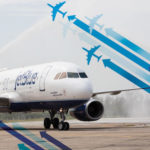
JetBlue’s Stoyanova Looks to the IFC Horizon
 Mariya Stoyanova, JetBlue’s head of product development, is the very definition of an In Flight Connectivity (IFC) influencer. She is one of the leaders behind JetBlue’s remarkable progress in the IFC arena. She, along with her team, have big ambitions to make JetBlue the standard when it comes to IFC. But, what does she think of the satellite industry and what does she want from the tech industry?
Mariya Stoyanova, JetBlue’s head of product development, is the very definition of an In Flight Connectivity (IFC) influencer. She is one of the leaders behind JetBlue’s remarkable progress in the IFC arena. She, along with her team, have big ambitions to make JetBlue the standard when it comes to IFC. But, what does she think of the satellite industry and what does she want from the tech industry?
It is a sunny autumnal day in Boston, a city I haven’t visited for almost two decades, but the venue for The Airline Passenger Experience Association (APEX) Expo — one of the key events for the airline industry when it comes to IFC. One of the highlights of the trip was sitting down with Stoyanova to talk about satellite tech, customer partnerships, passenger experience, and all things in between. Stoyanova is both candid and forceful at the same time while making a point. As a ‘blue chip’ customer for the satellite industry, when Stoyanova (and JetBlue) talks, the industry should listen.
JetBlue’s first connected aircraft was introduced around five years ago. It was part of its value proposition when the airline came into operation. It reached 100 percent fleet connectivity in 2017, which was a significant milestone. The company, a leisure based airline, has put IFC front and center in its strategy. Stoyanova admitted that she considers JetBlue, even in the hyper competitive North American market, “the market leader” when it comes to IFC. “We are more customer friendly than other carriers, as I believe it is more part of our JetBlue customer value proposition rather than an ancillary revenue strategy. This is where our strategy differs from other carriers. Our free product is better than most paid products that are being offered currently, especially in the U.S. market. I think that is the future. We do believe in seamless, uninterrupted living and removing those anxiety moments from the customer experience by providing them with a service they can rely on.”
One of the themes of APEX last year was larger airlines placing more of an emphasis on IFC. Stoyanova says the industry is “shifting” — especially the onboard experience. The experience used to be a commodity, and she believes that airlines became complacent in the way the way they sold and marketed IFC to customers. “Other airlines are investing in the product and moving towards a better experience overall,” she adds. “Where I still think I have the edge is we have a pretty consistent aircraft type. It is easier to sustain it. We operate the A320 family and now we will have the A220 family. We have a relatively consistent product offering. We have seatbacks at every seat. So, I think the consistency of the product and consistency of the fleet gives me a little bit of an edge from being simple and being able to manage the product and the offering better.”
Satellite Technology and What Stoyanova Wants?
JetBlue is one of the Viasat’s most high profile airline customers. Stoyanova came into the role when going down the Ka-band route had already been decided. She admits it was “definitely a risky” journey to go down, considering that at that time, not many (if any) airlines had decided to pursue Ka-band. “The first test flight we had with Viasat, we all looked at each other and said: this better work,” she says. “The first test flight was in 2013. I was part of the sourcing team at that point. I came at it from a different lens and different angle. But, it was very exciting.”
Stoyanova spoke to the value in Viasat’s satellite technology. “The value with Viasat is outside of their product,” she says. “They have the service on the ground. They have learnings on the ground that I can transfer into the air, which is very helpful. In terms of satellite technology, it is only getting better. They listen to our feedback and offer us solutions to optimize the product so we can provide a better experience.”
She says the technology industry (implying the satellite industry) is moving too slowly. She says that the lead times are “insane,” and unfortunately, the real world is moving much faster. “I understand how the aviation world works. Customers are getting more and more demanding so creating systems that provide flexibility and are future proofed will help me a lot. Things are changing so fast,” she says.
But how much satellite capacity is JetBlue actually using? While Stoyanova does not give an exact figure, she admits how the bandwidth is changing significantly. She points to the fact that years ago, there were no videos on Facebook’s newsfeed, and that there were no Instagram stories. These platforms have now become “essential” to customers but for JetBlue, they will need greater bandwidth to cope.
Using Satellite Providers Other Than Viasat
While JetBlue is undoubtedly happy with its work with Viasat, many other satellite operators are targeting the IFC market. As airlines examine their options moving forward, JetBlue could work with other providers. With many new satellites being launched in different orbits, is JetBlue actively considering other satellite companies for its IFC needs? “Whenever we have a retrofit program underway or a new aircraft type coming in, we always explore our options,” she says. “We have just ordered more than 60 A220s, so we are in the process of selecting IFC and connectivity providers. We’re always on the lookout for what’s new in the connectivity realm, but Viasat is the standard right now.”
Cracking the Code
In a recent interview with Via Satellite, Andrew Middleton of easyJet said no airline had cracked the IFC code or found the magic formula to be successful. So despite JetBlue’s success, does Stoyanova believe that JetBlue or another airline has cracked the code? “The way most airlines look at it is the revenue share model and the paid product. The partnerships are a part of it as well. People think we have a secret sauce. I don’t,” she says. “I just took a different path. We need to optimize for customer experience rather than talk about Service Level Agreements (SLAs) and Key Performance Indictators (KPIs). The industry is shifting, especially the onboard experience. It’s no longer about a plane taking you from point A to point B. Customers are not looking for a commodity, they are looking for an experience.”
Partnerships
Most airlines are getting connected. Some like JetBlue may have done it quicker than others, but most are connected or in the midst of getting connected. It means that to stand out from the crowd, airlines may have to partner with others to improve the overall experience. JetBlue has worked with Amazon in an innovative partnership, that allows JetBlue customers access to their Amazon services. They can stream, listen to music and shop. JetBlue promotes all those things when you are onboard. Stoyanova says these are not hooks designed for customers to pay the airline more. They are hooks for customers to have a better experience.
In terms of other partnerships, Stoyanova admits she sees a lot of value in them. “With Amazon, they saw the value in us owning the whole customer experience and them integrating into our system. For Amazon, those are people that are in a aircraft at 35,000 feet. You want get their attention for the duration of the flight,” she says. “So, this is totally incremental to everything else that you do. You have the ability to organically convert customers as you have your product in the air. The fact we offer Fly-Fi for free means this is completely organic and it is self-selected. It is not a forced offering. This is why it takes time to educate companies to build partnerships, but once they understand it, they see the results from the previous partnerships we have done, they jump on board.”
Yet, has the partnership with Amazon created any bandwidth bottlenecks? “When we set-up the partnership with Amazon, the three of us (JetBlue, Viasat and Amazon) did work hard to make sure the streaming product was optimized for our Fly-Fi product,” Stoyanova says.
The Next Chapter
Stoyanova is unphased about the epiphanies that some airlines seem to have had recently regarding IFC. She admits that in lieu of monitoring the competition, she gets her inspiration from outside the airline industry. “I look at the hospitality industry,” she says. “I would look at the Disney experience, for example. You would have some of the hotel chains as they are good at delivering curated services. Hospitality is really important. In Flight Entertainment (IFE) is just part of what we do. We own the whole onboard experience so food and beverage, the interiors, and the ground experience. For us, hospitality is a big part of what we do. If the inflight and airports crewmembers are not invested, it doesn’t work. Everybody has to be invested in it for it to work.”
She says her job is “getting more interesting,” but doesn’t believe it is getting harder. “I don’t like to get comfortable, [because] then you get complacent. I think this happened to a lot of the carriers back in the day. Airlines like JetBlue started to make them feel uncomfortable because they put something in the market that is providing more customer value. It made them move faster and in the right direction. I am happy for that. Challenging is not necessarily badshe says.
In terms of what is on deck for the airline over the next year, Stoyanova says the airline has a “a lot of big things coming up.” It has started retrofitting all of its A320s, so it will have a new IFE platform, interiors, etc. There will also be new portals. “I am looking forward to seeing how that will perform. We also have the A220s coming up,” Stoyanova says.
Check out the full version of this article as first published in Via Satellite.









